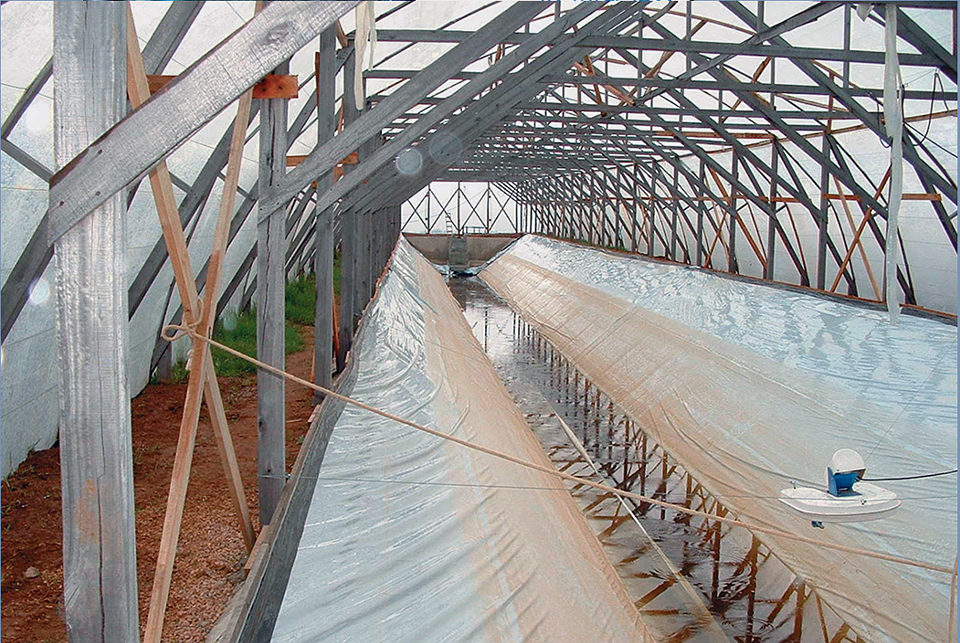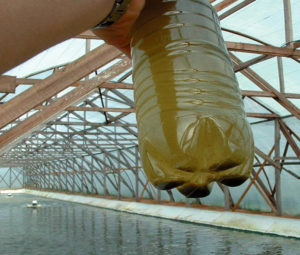Floc remained stable, always dark green in controlled facilities

The first experiments with tilapia bioflocs in subtropical southern Brazil were conducted in September 1998 using procedures similar to those the Oceanic Institute concept of mesocosms, aquatic controlled (MAC), applied to Litopenaeus vannamei shrimp.
The first experimental units were 20 200-L plastic indoor tanks with aeration, into which Oreochromis niloticus larvae were stocked at densities of 1-10/L. An objective was to overwinter them in commercial units at low cost.
The survival and feed-conversion ratios for fish at all densities were exceptionally good compared to the performance achieved using previously available techniques. However, growth was low, especially compared to shrimp produced in similar bacteria-based systems in Hawaii, USA, and Belize.
Greenhouse bioreactors
The preliminary results motivated in early 2000 the construction of commercial 1,000-cubic-meter V-shaped bioreactors inside two 800-square-meter plastic tunnel greenhouses. The aim of the units was to overwinter 300,000 1-gram tilapia fry purchased inexpensively at the end of the growout season in late May and sell large juveniles of up to 20 grams at top prices in September, just before the breeding season.
The results of this first commercial trial quickly changed when the fish grew to the targeted 20-gram size in the first 40 days, so it was impossible to sell them as juveniles 90 days later. The fish were kept growing with 25 percent of the forecasted feed in order to check the carrying capacity of the reactors and the growth curve up to market size.
The fish attained commercial size in 150 days with an average feed-conversion ratio of 0.77 and survival of 92 percent. However, the size variation was very large, and some fish grew 500 g in less than four months. While external temperatures averaged 5 to 10 degrees-C, water temperatures inside the greenhouses were never below 28 degrees-C, and the floc was very stable and always dark green.
The major changes to the MAC environment in these initial floc trials was the higher water temperatures and the presence of plankton influenced by the sunlight in the greenhouse.
Expansion, invention

By 2004, the project had 21 tilapia bioreactors and 16 commercial grow-out facilities in southern Brazil. One facility in Colombia was dedicated to mesocosm culture of first-feeding carnivorous larvae. Several in Ecuador and Angola handled nursery-phase tilapia juveniles.
Over the years, several protocols were developed. A water fertilization regime aimed at proper balancing of carbon, nitrogen and phosphorus levels to favor chlorophytes and avoid cyanophyte blooms. High-protein feeds were used to achieve excellent feed conversion. Salinity controls that favor inland polyculture with white shrimp were established to improve the taste of both tilapia and shrimp.
Recently, Storvik and Akvaforsk Genetics Center A.S. tested the effects of liquid oxygen at the FishSul facilities with promising results. The commercialization of tilapia culture in bioreactors is becoming a marketing success, with no diseases or water exchange reported over the last 10 years.
(Editor’s Note: This article was originally published in the May/June 2010 print edition of the Global Aquaculture Advocate.)
Author
-
Sergio Zimmermann
Akvaforsk Genetics Center A.S.
N-6600 Sunndalsøra, Norway
Tagged With
Related Posts

Responsibility
Woodchip bioreactors effectively treat aquaculture effluent
Woodchip bioreactors can efficiently remove nitrate, phosphorus and total suspended solids from aquaculture wastewaters. Denitrification treatment of the relatively organic-rich aquaculture wastewater is a new and useful application to protect against water pollution.

Responsibility
Emerging trends in salmonid RAS, part 2
Dozens of land-based, closed-containment salmonid RAS systems are coming on line. New projects are bringing new principles into the salmon industry. Industry expansion hinges upon the development of pollution-mitigating technologies to reduce nutrients in effluents.

Aquafeeds
Evaluating Nannochloropsis-based feeds for tilapia
This study assessed the efficacy and nutritional properties of the marine alga Nannochloropsis salina as a feed ingredient using tilapia (Oreochromis niloticus) as a model species. Results showed adequate growth, survival, FCR and enhanced EPA levels.

Aquafeeds
KnipBio partners with ICM to scale-up production of single-cell protein for aquaculture
Leader in fermentation, bio-refining technology a “great strategic fit” for single-cell protein aquafeed ingredient maker transitioning from R&D labs to commercial production.


